BadAssBees Index
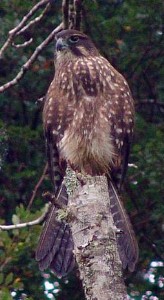
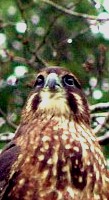
Karearea The New Zealand Falcon "Falco novaeseelandiae" |
|||
|
Click the thumbnails for a larger picture. This page operates ONE slave window. |
|||
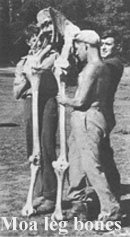 From millions of years of isolation in the vast expanse of the pacific, the wildlife of New Zealand remained free from mammalian predators until the arrival of humans in just the past few hundred years. With no ground-based predators to evade, many species of birds became ground-nesting or even flightless - some became gigantic, free from flight-based weight restrictions. But there were predators - raptor birds would also straggle to these shores, and similarly find ideal habitat here. With no mammalian competition  (and no nest-raiding rodents) the New Zealand birds of prey became as specialised as their quarry - Te Hokioi the 'Haast Eagle' (Harpagornis moorei) was named by the maori in imitation of its call, which was said to be an omen of war. Te Hokioi was the largest flying bird ever recorded, weighing over 14kg with a wingspan up to 3 metres, they preyed upon the Moa - the tallest bird ever - which stretched to over 3 metres tall (see also my kiwi rant). As the top predator on land, Te Hokioi could take prey too large to fly off with, and was feared by the maori as a risk to the young or weak (they were also called "Pouakai" - 'the big glutton').
(and no nest-raiding rodents) the New Zealand birds of prey became as specialised as their quarry - Te Hokioi the 'Haast Eagle' (Harpagornis moorei) was named by the maori in imitation of its call, which was said to be an omen of war. Te Hokioi was the largest flying bird ever recorded, weighing over 14kg with a wingspan up to 3 metres, they preyed upon the Moa - the tallest bird ever - which stretched to over 3 metres tall (see also my kiwi rant). As the top predator on land, Te Hokioi could take prey too large to fly off with, and was feared by the maori as a risk to the young or weak (they were also called "Pouakai" - 'the big glutton').

Tragically the more specialised the species, the less able they are to adapt to change, and with the arrival of the first humans, bringing with them fire, rats, and dogs - all eleven known species of Moa hastened to extinction in a bare two or three hundred years, and with them went Te Hokioi, leaving no trace but whitening bones, maori legends, and tantalising memories of rumoured sightings from early european explorers deep in the bush... (there is a good likelihood that a pair were shot by one Charlie Douglas in the late 1800's)  Many other NZ species disappeared too, and the smaller raptors were not immune, with the Eyles Harrier ('Circus eylesi') gone, Whekau ('Sceloglaux albifacies') the 'Laughing Owl' which ran down its prey on foot is now presumed extinct, and karearea the falcon rare. Ruru
Many other NZ species disappeared too, and the smaller raptors were not immune, with the Eyles Harrier ('Circus eylesi') gone, Whekau ('Sceloglaux albifacies') the 'Laughing Owl' which ran down its prey on foot is now presumed extinct, and karearea the falcon rare. Ruru
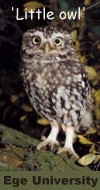 remains in healthy numbers ('Ninox novaeseelandiae'), known as Morepork to colonists, NZ shares this species of fluffy-footed owl with Australia, where their call is dubbed 'Boobook' (although it is unsure if these are in fact a separate species - they can at least hybridise). Smaller still, the day-hunting 'Little
Owl' (Athene noctua) can be found on the South Island's east coast, though these are not native. Kahu the Harrier hawk ('Circus approximans) is certainly also common in both Oz and NZ, finding plenty of carrion to eat on our indiscriminately killing highways - many folk incorrectly suppose that they don't catch live prey. Aside from these 4 breeding species, today only a few storm-blown individuals of other raptor species turn-up here from time to time.
remains in healthy numbers ('Ninox novaeseelandiae'), known as Morepork to colonists, NZ shares this species of fluffy-footed owl with Australia, where their call is dubbed 'Boobook' (although it is unsure if these are in fact a separate species - they can at least hybridise). Smaller still, the day-hunting 'Little
Owl' (Athene noctua) can be found on the South Island's east coast, though these are not native. Kahu the Harrier hawk ('Circus approximans) is certainly also common in both Oz and NZ, finding plenty of carrion to eat on our indiscriminately killing highways - many folk incorrectly suppose that they don't catch live prey. Aside from these 4 breeding species, today only a few storm-blown individuals of other raptor species turn-up here from time to time.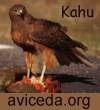 Many people confuse hawkes with falcons, often assuming they are one and the same, their confusion plain to see when told how rare Karearea is. Kahu are commonly seen on a drive through the countryside, soaring effortlessly on a whisper of wind, or flapping lazily away when disturbed at some roadkill (or worse, standing ground over their prize - they are frequently roadkill themselves). With a similar shape and colouring to falcons, they can be easily mistaken by those with little interest. But put them side by side and the difference is obvious.
Many people confuse hawkes with falcons, often assuming they are one and the same, their confusion plain to see when told how rare Karearea is. Kahu are commonly seen on a drive through the countryside, soaring effortlessly on a whisper of wind, or flapping lazily away when disturbed at some roadkill (or worse, standing ground over their prize - they are frequently roadkill themselves). With a similar shape and colouring to falcons, they can be easily mistaken by those with little interest. But put them side by side and the difference is obvious. Kahu are a larger bird, up to just under 1kg they are roughly twice the weight of karearea, with long legs suited to ground feeding. In flight the hawk soars often, flapping only slowly even when mobbed by territorial Tui and Magpie, intent on driving the threat away from their nests.  Karearea usually take prey on the wing. They fly fast and agile, with rapid wingbeats, and are not phased by windy, gusty conditions (they seem to revel in it). They seldom eat carrion, with short legs more suited to perching. Falcons are said to be the worlds fastest-flying birds, cruising at a shade under 100 km/hr in normal flight, Peregrine falcons have been clocked on radar at over 320km/hr diving vertically for a kill. Karearea classically have a 'moustach' marking of darker feathers on the face.
Karearea usually take prey on the wing. They fly fast and agile, with rapid wingbeats, and are not phased by windy, gusty conditions (they seem to revel in it). They seldom eat carrion, with short legs more suited to perching. Falcons are said to be the worlds fastest-flying birds, cruising at a shade under 100 km/hr in normal flight, Peregrine falcons have been clocked on radar at over 320km/hr diving vertically for a kill. Karearea classically have a 'moustach' marking of darker feathers on the face.
Falcons around the world are known for their fearlessness, and Karearea is not lacking in this trait. Richard Seaton has worked with raptors in England, Mauritius and Madagascar, and writes of an encounter with karearea near their nest: |
|
The Peregrine falcon (Falco peregrinus) is infamous for its ferocity, and often considered to be the epitomy of falcons. Aside from the polar regions, it is present throughout the world including Pacific Islands even more remote than NZ. Considering their range everywhere else, the Peregrine is conspicuous in NZ by its absence, which suggests that the local karearea are at least a match for their more famous cousins.
However it seems likely that their uncompromising attitude is a contributing factor to their  scarcity today. Karearea have little respect for humans with guns, and are more likely than hawks to stand their ground despite uneven competition. They will take domestic poultry, even following their fleeing quarry indoors. The NZBirds website has a story of a falcon beaten to death because it would not relinquish its hold on the farmer's chicken. I am aware of another instance from Otago where a farmer complained that karearea from a nearby nest were divebombing his dogs, and the local DOC officer (where the 'C' supposedly stands for 'conservation') suggested pricking the eggs of this protected endangered species to make the adults abandon it (subsequently the nest and the birds 'disappeared' - yet i don't believe any charges were laid).
scarcity today. Karearea have little respect for humans with guns, and are more likely than hawks to stand their ground despite uneven competition. They will take domestic poultry, even following their fleeing quarry indoors. The NZBirds website has a story of a falcon beaten to death because it would not relinquish its hold on the farmer's chicken. I am aware of another instance from Otago where a farmer complained that karearea from a nearby nest were divebombing his dogs, and the local DOC officer (where the 'C' supposedly stands for 'conservation') suggested pricking the eggs of this protected endangered species to make the adults abandon it (subsequently the nest and the birds 'disappeared' - yet i don't believe any charges were laid).
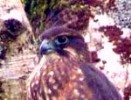 In my own experience i had little trouble photographing my resident bird for this page - and it takes far more skill to get a good shot with a camera than with a rifle or shotgun. Some folk accuse raptors of killing new lambs, but while Hawks in particular will eat a dead lamb, there is little evidence to suggest that they are responsible for its death.
In my own experience i had little trouble photographing my resident bird for this page - and it takes far more skill to get a good shot with a camera than with a rifle or shotgun. Some folk accuse raptors of killing new lambs, but while Hawks in particular will eat a dead lamb, there is little evidence to suggest that they are responsible for its death.
Humans are also responsible for the other major reasons for the decline of karearea - habitat loss and introduced predators. The polynesians who settled here in the last thousand years brought with them dogs, rats and fire - clearing significant area of forest cover. In the past 150 years with the influx of colonising europeans, most of the rest has been cleared for timber and farmland, reducing karearea habitat (though open country is prefered by kahu). In addition, europeans brought many other mammalian predators, particularly Rattus rattus and Rattus norvegicus ('ship' and 'norwegian' rats), and mustelidae (weasels, stoats, and ferrrets) efficient nest raiders of ground nesting Falcons. Rarely found in the upper half of the North Island, karearea tend to be larger the further they live from the equator (as is common in many species). Three races of karearea have been suggested - Bush, Eastern, and Southern - though it seems these have been arbitrarily divided according to geographic zones - they are not distinct and will readily interbreed where their territories overlap. Like many rare NZ birds  karearea are usually ground nesting, in a scrape or hollow, under logs or overhangs, they use no nesting material, although 'Bush' falcons may nest high in a secure tree fork or clinging epiphyte. Pairs mate for life, bonding with high-flying noisy aerial displays including high-speed food passes, they nest in spring between August and January, raising one clutch of up to 3 young. Female falcons are twice the weight of males, and while the young are near full sized when they leave the nest around mid-summer, the parents may continue to bring food to the juvenile bird for some months afterward.
karearea are usually ground nesting, in a scrape or hollow, under logs or overhangs, they use no nesting material, although 'Bush' falcons may nest high in a secure tree fork or clinging epiphyte. Pairs mate for life, bonding with high-flying noisy aerial displays including high-speed food passes, they nest in spring between August and January, raising one clutch of up to 3 young. Female falcons are twice the weight of males, and while the young are near full sized when they leave the nest around mid-summer, the parents may continue to bring food to the juvenile bird for some months afterward.
 There are no comprehensive figures for the number of karearea surviving today, though Wingspan estimates no more than 1500 pairs in total. Although they have been fully protected for over 30 years their numbers are still so critically low that they are classified as a 'threatened' species - the second highest conservation priority. Karearea appear on the NZ Twenty Dollar note, but are disappearing from our environment.
There are no comprehensive figures for the number of karearea surviving today, though Wingspan estimates no more than 1500 pairs in total. Although they have been fully protected for over 30 years their numbers are still so critically low that they are classified as a 'threatened' species - the second highest conservation priority. Karearea appear on the NZ Twenty Dollar note, but are disappearing from our environment.
I realised a few years ago that i had falcons at Mt Elliot, when i was erecting my hut i would  often be watched from a low branch on a nearby tree. That same year i was privileged to see high altitude aerial acrobatics by a bonding pair, including food thrown and caught by the partner. I had seen a falcon previously whilst beekeeping in the back country of Golden Bay near the start of the Heaphy track, but had little idea how fortunate i was to encounter these rare birds until events this year (2004) led me to find out a bit more about them.
often be watched from a low branch on a nearby tree. That same year i was privileged to see high altitude aerial acrobatics by a bonding pair, including food thrown and caught by the partner. I had seen a falcon previously whilst beekeeping in the back country of Golden Bay near the start of the Heaphy track, but had little idea how fortunate i was to encounter these rare birds until events this year (2004) led me to find out a bit more about them.
Around midsummer (January) i became aware of two things - a persistent  INsistent unfamiliar raucous birdcall, and one of my chooks (poultry) seemed to be missing.
I couldn't remember whether i had previously had 13 or 14 chooks so paid little attention at the time, but it didn't take long to identify the new noisemaker, as she unselfconsciously would shriek her arrival, and sit nearby on any prominent vantage point.
INsistent unfamiliar raucous birdcall, and one of my chooks (poultry) seemed to be missing.
I couldn't remember whether i had previously had 13 or 14 chooks so paid little attention at the time, but it didn't take long to identify the new noisemaker, as she unselfconsciously would shriek her arrival, and sit nearby on any prominent vantage point.
A few days later Stimpy was missing, one of my long-legged roosters with an unusual stippled comb. As i had 6 roosters in their prime at that time with Stimpy number 3 in the pecking order, i wondered whether he had simply moved on to find an harem for himself. I considered whether the noisy new falcon might be involved but to me it seemed unlikely, with Stimpy having about a 4:1 weight advantage, and being a bit of a scrapper besides. 20:20 hindsight is a wonderful thing... But then Studley vanished, and i knew HE wouldn't have simply left, and now realising that something was predating them i started doing some research on karearea. I also noticed that the remaining birds now spent all their time undercover, unless i was about. I soon discovered that karearea will take on prey up to 7 or 8 times their own weight (!), including Blackback Gulls, ducks, rabbits - and are quite partial to domestic poultry... My reading has yet to find a list of their bread'n'butter NATIVE species, with most writers prefering to list the introduced species typically predated now - starlings, finches, skylarks. Debbie from Wingspan says that she's yet to see any Tui or Korimako (Bellbirds) taken, and that she's even seen fantails hovering around falcons like fluttering butterflies - without being "even looked at", theorising that it may have a lot to do with flight patterns - the fright/flee response that stimulates falcons to attack. They're also known to eat large insects, lizards, and rodents. | |||||
My chooks had come to me via 'Bird Rescue' in Christchurch, a humane charity that rescues birds and provides medical care after dog attacks, road-strikes, mistreatment - wherever they find birds in need. Many of their patients are domesticated birds, and cannot be simply released into the wild when they have recovered. Finding enough homes for such birds to go to after recovery is an ongoing logistical problem for Linda from Bird Rescue.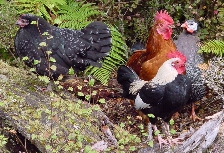
 Visit Bird rescue at www.birdrescue.co.nz
Visit Bird rescue at www.birdrescue.co.nzThey especially have problems with roosters, because most people regard them as food, so Linda is inevitably suspicious of the motives when folk offer to take roosters off their hands. Having seen that i don't eat their patients, Bird Rescue had happily sent more my way, to live out their days in what was expected to be an idyllic safe rural environment. They each had their own personality and frequently amused me with their varied antics. Before the midsummer arrival of my juvenile karearea, i had 6 roosters, 6 hens, and 2 gender-unknown 'tufted guinea fowls'. When it became apparent that the Falcon was responsible for their disappearing, my only option was to get them away (although an aquaintance suggested that i "take [the falcon] 'off its feet' [bang]". NZ likes to imagine that we have a strong conservation ethic here, but the reality is that many individuals still care little about any other species). |
|||||
|
The classic karearea territorial call is a high-pitched 'kekekekek' (sound bite here). Through contact with Wingspan i have learned that the raucous call 'my' bird uses (the background call on this page) is typical juvenile begging for food when she sights one of her parents. The observed arrival time in Midsummer corresponds with typical time of year for chicks to leave the nest. I have subsequently seen a smaller bird (males are smaller than females) drop food which was caught on the wing by his larger daughter, verifying Wingspan's assessment.
Now that there are no easy chickens left, 'Junior' doesn't sit quite so close to my hut anymore, prefering instead to sit at the top of a tree behind. I've yet to see her actually make a kill - or even attempt to - herself, though i guess thats more an indication of a bird well-fed than any inability on her part. As with any family, there will come a time when mum and dad stop supporting her, and she has to do it all for herself. I hope she will stay in the area - she certainly seems to regard my clearing as her home patch currently. I look forward to being treated to future mating flights and aerial exchanges, and hope that elsewhere in their range these magnificent raptors hold their own with increased human understanding and tolerance for the other species that share these islands, whether native, or recent migrants like our ourselves... |
|||||
In memorial
This page came about as a result of my efforts to determine whether a falcon was likely to be eating the rescued chooks in my care.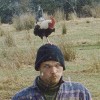 I particularly miss 'Studley', the black & white bantam in the above photo. He was the smallest in stature, but larger than life in character, always posing, constantly crowing, attacking my ankles from behind (and then standing ground ready to fight me, looking like a frilled lizard with his feathers up), sneaking inside whenever he could (and trying to nestle down to sleep in the duvet) - he was a real pain in the ass sometimes.
I particularly miss 'Studley', the black & white bantam in the above photo. He was the smallest in stature, but larger than life in character, always posing, constantly crowing, attacking my ankles from behind (and then standing ground ready to fight me, looking like a frilled lizard with his feathers up), sneaking inside whenever he could (and trying to nestle down to sleep in the duvet) - he was a real pain in the ass sometimes.
But he really just wanted attention - he would sit happily on my shoulder (or head), and when i scratched his comb he would close his eyes and slowly tip his head right back until he over-balanced and had to come out of his trance to avoid falling over. With his antics and because he chose to interact, he helped show visitors that chickens are 'people' too, not mere egg-laying pieces of feather-covered white meat, to be crammed into tiny wire cages and made to suffer their entire lives just to lower the cost of eggs by a few cents. You gave me many smiles Studley - peace to you wherever you are. |
|||||
|
How often i hear that humans are 'more highly evolved' than other species. It doesn't seem right then that lesser-evolved creatures should possess retractable claws or prehensile tails, dolphin sonar or bat echo-vision, a bloodhound's nose or an eagle's sight, while i go without. I'm more highly evolved, so why can't i breathe underwater like a fish, or see heat like a snake? I'm better than they - its been declared! But i'd trade my common primate thumb for a decent pair of wings... - Me (Pav) | |||||

|
|||||
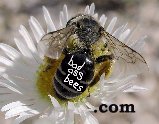 BadAssBees Index |
|||||
Email Me
Uploaded 18/5/4